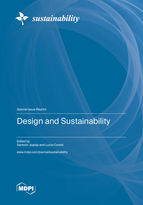Design and Sustainability
A special issue of Sustainability (ISSN 2071-1050). This special issue belongs to the section "Sustainable Products and Services".
Deadline for manuscript submissions: closed (26 March 2023) | Viewed by 36258
Special Issue Editors
Interests: design for sustainability; product–service system (PSS); design for marginalised societies; social sustainability; design creativity; co-design; frugal innovations; industrial design
Interests: design for social sustainability; design for marginalised societies; humanitarian design; design for development; distributed manufacturing; digital fabrication
Special Issues, Collections and Topics in MDPI journals
Special Issue Information
Dear Colleagues,
Design is essential to address social, economic and environmental challenges faced by societies around the world. Designing appropriate solutions is imperative to contribute towards dignity, inclusivity, health, well-being and sustainable development of high-, middle- and low-income societies, of children, adults and the elderly and of those living in rural, urban and remote areas. In essence, designing sustainable solutions is crucial to support development of all individuals and communities across the globe and to contribute towards the UN Sustainable Development Goals (SDGs). The process of designing such solutions, which can manifest in the form of products, services and product–service systems (PSS), provides maximum scope to influence their technological, functional, aesthetic, ergonomic and many other attributes, with a profound impact on their social, economic and environmental qualities. Therefore, to support design and development of sustainable products, services and PSS, it is important to understand their design process and develop related models and theories. It is also crucial to develop and evaluate design methods and tools to support individuals, companies and organisations in designing sustainable products, services and PSS.
For this Special Issue titled “Design and Sustainability”, we invite the submission of articles that foster discussion on the design and development of products, services and PSS that are socially, economically and environmentally sustainable. We welcome papers that consider integrated models of sustainability, as well as work that reflects on the often overlooked ‘softer’ dimension of social sustainability. In this Special Issue, we also encourage papers that give a voice to marginalised groups, including women, indigenous and poor populations, who often face the worst effects of sustainability challenges such as climate change.
We encourage contributions that address issues related (but not limited) to the following areas concerning sustainable design of products, services and PSS:
- Design for social sustainability, design for equality, inclusive design;
- Design for marginalised societies, design at the Base of the Pyramid, humanitarian design, development engineering, appropriate technology;
- Industrial design, user-centred design, user interaction design;
- Design of social innovations, frugal innovations, grassroots innovations;
- Design for sustainable behaviour;
- Design for circular economy, product lifecycle management;
- Co-design, co-creation, participatory design;
- Role of new and emerging technologies, methods and techniques (e.g., digital fabrication, Artificial Intelligence, Internet of Things, data analytics) in designing for sustainability;
- Transitions design, design for sustainability transitions, design for systemic change;
- Feminist, gender and decolonial perspectives on design and sustainability;
- Design education and sustainability.
Articles selected for this Special Issue will be subject to a rigorous peer-review procedure with the aim of rapid and wide dissemination of research results, developments, and applications.
Dr. Santosh Jagtap
Dr. Lucia Corsini
Guest Editors
Manuscript Submission Information
Manuscripts should be submitted online at www.mdpi.com by registering and logging in to this website. Once you are registered, click here to go to the submission form. Manuscripts can be submitted until the deadline. All submissions that pass pre-check are peer-reviewed. Accepted papers will be published continuously in the journal (as soon as accepted) and will be listed together on the special issue website. Research articles, review articles as well as short communications are invited. For planned papers, a title and short abstract (about 100 words) can be sent to the Editorial Office for announcement on this website.
Submitted manuscripts should not have been published previously, nor be under consideration for publication elsewhere (except conference proceedings papers). All manuscripts are thoroughly refereed through a single-blind peer-review process. A guide for authors and other relevant information for submission of manuscripts is available on the Instructions for Authors page. Sustainability is an international peer-reviewed open access semimonthly journal published by MDPI.
Please visit the Instructions for Authors page before submitting a manuscript. The Article Processing Charge (APC) for publication in this open access journal is 2400 CHF (Swiss Francs). Submitted papers should be well formatted and use good English. Authors may use MDPI's English editing service prior to publication or during author revisions.
Keywords
- design for sustainability
- design for circular economy
- social sustainability
- social innovation
- product–service systems
- Base of the Pyramid
- frugal innovations
- well-being
- industrial design
- design methods and tools







